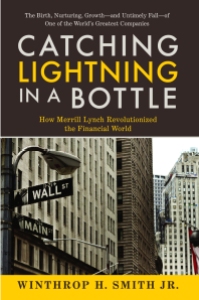
Secrets and How to Keep Them By James Marc Leas
January 14, 2014WTC Tower 7: An Attack from Within by Vidda Crochetta
January 21, 2014Catching Lightning In a Bottle

Like many other thinking citizens these days, I am fond of demonizing Wall Street. After all, Wall Street deserves demonizing, given the extraordinary corruption, excess and sheer financial hubris that has characterized the U.S. corporate financial system during the past decade. In his must-read and now-famed 2009 Rolling Stone article entitled “The Great American Bubble Machine,” gonzo indy journalist Matt Taibbi described Goldman Sachs, the world’s most powerful investment bank, as a “great vampire squid wrapped around the face of humanity, relentlessly jamming its blood funnel into anything that smells like money.” He may as well have been describing Wall Street itself, a place so storied, so mythical, so powerful, and so dedicated to the production of what one wag laughably called “something out of nothing,” as well as a deservedly symbolic target for the astonishing and ever-widening gap between the super rich and the rest of U.S. in this new millennium. As #OccupyWallStreet (yes, they are still very much alive and well) reminds us this month, disturbing new data indicate that, in the past five years since 2008’s Great Financial Meltdown, the richest 1% have gained $6.1 trillion (with a T) in wealth, while the average American family’s net worth has barely recovered.
So imagine my surprise at reading Winthrop H. Smith Jr’s epic new book Catching Lightning In A Bottle: How Merrill Lynch Revolutionized the Financial World and being reminded that the history and culture of Wall Street is perhaps a bit more complex than we sometimes remember in the midst of our collective rage with Wall Street these days.
Many of us here in Vermont’s Mad River Valley know “Win” as the affable and philanthropically-minded co-owner of Sugarbush Ski Resort. What some may not know is this: before he left Wall Street to become a Vermont ski bum (his term, not mine), Mr. Smith spent close to three decades at Merrill Lynch, or “Mother Merrill,” as the firm is still affectionately known by veterans. As the son of one of Merrill Lynch’s co-founders, Mr. Smith served as executive vice president, a member of the Executive Management Committee, and traveled the world as Chairman of Merrill Lynch International, before ultimately resigning from the firm due to organizational and cultural disagreements with CEO E. Stanley O’Neal, who took over Mother Merrill in 2003. Smith pulls no punches in his book, castigating O’Neal for radically changing the direction and ethical compass of Merrill Lynch and wrecking what was once a humane company. O’Neal’s “disdain for the Mother Merrill culture embraced by all his predecessors,” Smith concludes, “brought down a great firm.”
Weighing in at close to 600 pages, Smith’s book feels intimidating at first heft, but is surprisingly readable for an epic financial history. Told in an intimate first-person style, Win’s account of growing up in a world of privilege and power is fascinating. Particularly telling is his love and deep admiration for his father, Winthrop H. Smith, whom Win describes as “a skilled leader and humble man” whose “steady command brought Wall Street to Main Street.” Smith also provides a remarkable insider’s account of the history of Merrill Lynch, beginning with its 1914 founding by “charismatic, creative visionary” Charles E. Merrill, who cut his teeth in the grocery and brokerage industries, and the “disciplined” Edmund C. Lynch who provided the “check-and-balance” of the start up relationship. Win credits his father, meanwhile, for “bringing Wall Street to Main Street,” teaching ordinary Americans about the power of investing and making Wall Street accessible to the average Joe for the first time in U.S. history. Indeed, the book’s cover photograph, featuring a New York City Wall Street/Main Street sign post, suggests that this is Merrill Lynch’s most significant legacy in the author’s mind.
Most interesting, perhaps, are the book’s conclusions about Merrill Lynch and the future of Wall Street more universally. Smith holds CEO E. Stanley O’Neal and a compliant Merrill Lynch Board of Directors accountable for Mother Merrill’s near-collapse, and, in one moving scene, recounts his appeal to the “Principles” that defined his beloved firm during a company conference call shortly before his departure. “Someone once said you can never love a firm because it can’t love you back,” Smith stated during that fateful phone conversation. “Well, that person never knew Merrill Lynch. Our firm is our people, and the love and respect you have shown me is why I love Merrill Lynch and each of you.” Smith left the firm shortly thereafter, and watched as “The Death of Mother Merrill” (Chapter 14) unfolded against the larger corrupt collapse of Wall Street firms: Enron, Tyco, Adelphia, WorldCom – and, of course, the post-implosion “retirement” of (now dead) Mother Merrill CEO O’Neal with a $261 million severance package, an obscene but all-too-typical “golden parachute” outcome that still rankles Smith to this day.
As we consider what the future holds for Wall Street and the United States Empire as a whole, Catching Lightning In A Bottle serves as a valuable history, a memoir, and a cautionary tale well worth reading. While I remain angry with Wall Street, I now have a better understanding of one firm’s attempt to navigate a tumultuous century of financial management, as well as the problems hubris can bring to what was once, perhaps, one of Wall Street’s more humane corporations. Kudos to Mr. Smith for putting pen to paper and telling the Merrill Lynch story from his own insider’s experience.
You can pick up the book at one of our many local libraries, and find out more at www.smith-merrillhistory.com.
Image here
Share this:
- Click to print (Opens in new window)
- Click to email a link to a friend (Opens in new window)
- Click to share on Twitter (Opens in new window)
- Click to share on Facebook (Opens in new window)
- Click to share on Reddit (Opens in new window)
- Click to share on LinkedIn (Opens in new window)
- Click to share on Tumblr (Opens in new window)


